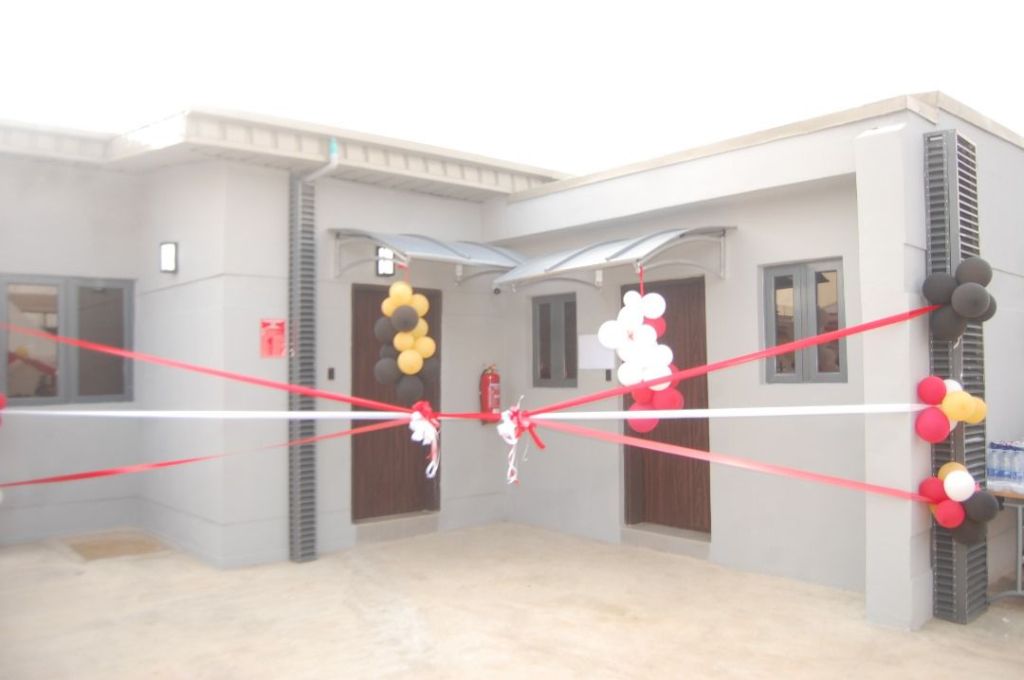 Physical security deals with measures that are designed to deny access to unauthorized personnel (including attackers) from physically accessing a building, facility, resource, or stored information; and guidance on how to design structures to resist potentially hostile acts. Physical security can be as simple as a locked door or as elaborate as multiple layers of barriers, armed security guards and guardhouse placement. Good physical security uses the concept of layered defense, in appropriate combinations to deter and delay intrusions (passive defense), and detect and respond to intrusions (active defense). Ultimately it should be too difficult, risky or costly to an attacker to even attempt an intrusion. However, strong security measures also come at a cost, and there can be no perfect security. It is up to a security designer to balance security features and a tolerable amount of personnel access against available resources, risks to assets to be protected, and even general aesthetics of the facility to be secured. There are also life-cycle sustaining costs to consider.
Physical security deals with measures that are designed to deny access to unauthorized personnel (including attackers) from physically accessing a building, facility, resource, or stored information; and guidance on how to design structures to resist potentially hostile acts. Physical security can be as simple as a locked door or as elaborate as multiple layers of barriers, armed security guards and guardhouse placement. Good physical security uses the concept of layered defense, in appropriate combinations to deter and delay intrusions (passive defense), and detect and respond to intrusions (active defense). Ultimately it should be too difficult, risky or costly to an attacker to even attempt an intrusion. However, strong security measures also come at a cost, and there can be no perfect security. It is up to a security designer to balance security features and a tolerable amount of personnel access against available resources, risks to assets to be protected, and even general aesthetics of the facility to be secured. There are also life-cycle sustaining costs to consider.
Physical security is not a modern phenomenon. It exists in order to deter persons from entering a physical facility. Ancient examples of physical security include city walls, moats, etc. Notably, however, the technology used for physical security has changed over time. While in past eras, there was no passive infrared (PIR) based technology, electronic access control systems, or video surveillance system (VSS), the essential methodology of physical security has not altered much over time.
Physical security procedures include, but are not limited to;
(a) Using physical security equipment or measures to reduce vulnerability to a threat.
b) Integrating physical security into contingency, mobilization, and wartime plans, and testing physical security procedures and measures during the exercise of these plans.
c) Coordinating crime prevention, and physical security programs to protect against the total criminal element.
(d) Training guards at sensitive sites in tactical defense against, and response to, attempted penetrations.
(e) Creating physical security awareness.
Physical security measures are security equipment, procedures, or devices used to protect physical security interests from real and possible threats. They include, but are not limited to:-
(1) Security guards.
(2) Military working dogs.
(3) Physical barriers.
(4) Badging systems.
(5) Secure containers.
(6) Locking devices.
(7) Intrusion detection systems (IDS).
(8) Security lighting.
(9) Assessment or surveillance systems such as closed-circuit television (CCTV) or spy cameras.
(10) Access control devices.
(11) Facility hardening.
Fundamentally, good physical security is a combination of defensive principles designed to:
- Deter
- Delay
- Detect
- Respond, and ultimately, deny access to unauthorized intrusions into critical physical spaces.
The first two actions of deter and delay are considered passive defense, while the remaining are active in nature.
Deter, Delay, Detect and Respond!
Using a combination or layer of systems, equipment and active procedures which are deployed to constitute the first and basic line of defense in a facility, security threats can be easily identified, isolated and eliminated. There may be many choices to consider but there is no “best” solution that will satisfy a broad class of situations. Each situation is unique.
However, the main goal of physical security is to convince potential attackers that the likely costs of attack exceeds the value of making the attack, meaning that the consequences of a failed attack may well exceed the gains. This combination of layered security features establishes the presence of “territoriality”.
For example, the initial layer of security for a university campus, residential building, office complex, or other physical space would comprise the use of crime prevention models environmentally designed to deter threats. Some of the most common examples are also the most basic – such as warning signs, fences, vehicle barriers, vehicle height-restrictors, restricted access points, proper site lighting and trenches. However, even passive things like a row of shrubs, plants, or trees trained to grow together to create a dense barrier (hedgerows) may be sufficient in some circumstances.
 The next layer is mechanical and includes gates, doors, and locks. Key control of the locks can become a problem especially with large user populations and therefore quickly become unmanageable, often forcing the adoption of electronic access control. Electronic access control, on the other hand, easily manages large user populations, controlling for user lifecycles, times, dates, and individual access points. For example a user’s access rights could allow access from 0700hrs to 1900hrs Monday through Friday and expires in 90 days. Another form of access control (procedural) includes the use of policies, processes and procedures to manage the ingress into the restricted area. An example of this is the deployment of security personnel conducting checks for authorized entry at predetermined points of entry. This form of access control is usually supplemented by the earlier forms of access control (i.e. mechanical and electronic access control), or simple devices such as physical passes. An additional sub-layer of mechanical/electronic access control protection is reached by integrating a key management system to manage the possession and usage of mechanical keys to locks or property within a building or perimeter.
The next layer is mechanical and includes gates, doors, and locks. Key control of the locks can become a problem especially with large user populations and therefore quickly become unmanageable, often forcing the adoption of electronic access control. Electronic access control, on the other hand, easily manages large user populations, controlling for user lifecycles, times, dates, and individual access points. For example a user’s access rights could allow access from 0700hrs to 1900hrs Monday through Friday and expires in 90 days. Another form of access control (procedural) includes the use of policies, processes and procedures to manage the ingress into the restricted area. An example of this is the deployment of security personnel conducting checks for authorized entry at predetermined points of entry. This form of access control is usually supplemented by the earlier forms of access control (i.e. mechanical and electronic access control), or simple devices such as physical passes. An additional sub-layer of mechanical/electronic access control protection is reached by integrating a key management system to manage the possession and usage of mechanical keys to locks or property within a building or perimeter.
The third layer is intrusion detection systems or alarms. Intrusion detection systems monitors for unauthorized access. It is less a preventative measure and more of a response trigger, although most security operators would argue that it is a deterrent. Intrusion detection has a high incidence of false alarms. In many countries, law enforcement will not respond to alarms from intrusion detection systems for obvious reasons. For example, a motion sensor near a door could trigger on either a person or a mouse! The sensor itself does not do identification and as far as it is designed, anything moving near that door is unauthorized.

A typical outdoor surveillance camera installation
The last layer is video surveillance monitoring systems. The presence of security cameras can be a deterrent in many cases, but their real power comes from incident verification during investigation and for historical analysis. For example, if alarms are being generated and there is a camera in place, the camera could be viewed to verify the alarms. In instances when an attack has already occurred and a camera is in place at the point of attack, the recorded video can be reviewed. Although the term closed-circuit television (CCTV) is common, it is quickly becoming old-fashioned as modern video systems lose the closed circuit for signal transmission and are instead transmitting on computer networks via the internet. Advances in information technology are transforming video monitoring into video analysis. For instance, once an image is digitized it can become data that sophisticated algorithms can act upon. As the speed and accuracy of automated analysis increases, the video system could move from a monitoring system to an intrusion detection system or access control system. It is not difficult to imagine a video camera inputting data to a processor that outputs to a door lock. Instead of using some kind of key, whether mechanical or electrical, a person’s visage becomes the key. When actual design and implementation is considered, there are numerous types of security cameras that can be used for many different applications. One must therefore analyze their needs and choose accordingly.

Command and Control Surveillance Center for Rapid Response
Note however that video monitoring does not necessarily guarantee that a physical response is made to an intrusion. A human must be monitoring the situation in real time in order to respond in a timely manner. Otherwise, video monitoring is simply a means to gather evidence to be analyzed at a later time – perhaps too late in some cases.
Intertwined in these four layers are people. Guards have a role in all layers, in the first as patrols and at checkpoints; in the second, to administer electronic access control; in the third, to respond to alarms. The response force must be able to arrive on site in less time than it’s expected that the attacker will require to breach the barriers. And in the fourth, to monitor and analyze video data. Users obviously have a role also by questioning and reporting suspicious people, movements and activities.
Also, in identifying people as “known” versus “unknown”, intelligent identification

Guards on patrol
systems can be deployed at specific entry points. Often photo ID badges are used and are frequently integrated into the electronic access control system. Visitors are often required to wear a visitor access badge inside a secured facility. Many installations, serving a myriad of different purposes, have physical obstacles in place to deter intrusion. This can be high walls, barbed wire, broken glasses mounted on top of walls, armed security guards, electric security fencing and light beams, etc. The presence of PIR-based motion detectors is common in many places, as a means of noting intrusion into a physical installation. Moreover, VSS/CCTV cameras are becoming increasingly common, as a means of identifying persons who intrude into physical locations.
Automatic Teller Machines (cash dispensers) are protected, not by making them invulnerable, but by spoiling the money inside when they are attacked or compromised. Money tainted with a dye could act as a flag to the money’s unlawful acquisition.
In the public sector, government agencies with responsibility for homeland security such as the police must be adequately trained to detect, identify, isolate and eliminate threats in a most swift and timely manner. Today, in major cities across Nigeria such as Lagos, Abuja, and Port Harcourt the various State governments have deployed video surveillance systems to facilitate crime detection and prevention.
Although physical security is the responsibility of Commanders, Directors, Supervisors, and Officers in charge, whether military or civilian, it is nevertheless the responsibility of all who care enough about their personal safety in today’s dangerous society. Therefore, physical security programs should be developed to provide reliable means to counter threat entities during peacetime, mobilization, and wartime. Such threats could include hostile intelligence services, paramilitary forces, terrorists or saboteurs, criminal elements, protest groups and disaffected persons.
© 2011 Prince Bright Eweka












Recent comments…